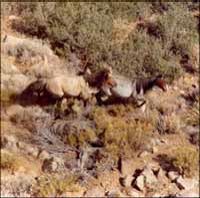 Cerbat mustangs on the Cerbat HMA, Arizona Cerbat mustangs on the Cerbat HMA, Arizona | |
| Country of origin | United States |
|---|---|
| Traits | |
| Distinguishing features | Build is similar to the classic Andalusian horse. |
The Cerbat mustang is a feral horse population of Arizona, found in the Cerbat Herd Management Area in that state. Their main coat colors are chestnut, bay, and roan. While their phenotype is similar to the classic Colonial Spanish horse, the actual origin of Cerbat mustangs is unclear, but they have been identified by DNA testing as of Colonial Spanish horse ancestry, and they are recognized by the Spanish Mustang registry as valid foundation stock for that standardized breed. Cerbats possess the ability to gait.
Characteristics
The Cerbat mustang is said to be similar to the classic Andalusian horse in conformation, and has characteristics consistent with Spanish horse type. They are 14 to 15 hands (56 to 60 inches, 142 to 152 cm) tall, and average 750 to 800 pounds in weight. The first generation in captivity, however, was said to stand only 13.2 hands (54 inches, 137 cm). Cerbats are most commonly bay and roan, but there are some grays, blacks, sorrels, and duns found on the Cerbat Herd Management Area (HMA) in Arizona. Those in private hands are said to only be bay, roan, or chestnut. White markings on legs and heads are common. Roan Cerbat foals are born roan, unlike some roan foals of other stock that are born a dark color and "roan out" as they get older, fading in color. They are considered calm, quiet, and intelligent. Some Cerbats can perform intermediate ambling gaits.
The feral horse bands today are found in Arizona. For this reason, they are accepted by the Spanish Mustang registry. There is no formal Cerbat horse registry at present and the variety is very rare in captivity, with a high number of 45 horses registered, and a stable number of about 70 feral individual still found in the Cerbat HMA.
History

The Cerbat mustang is named for the Cerbat Mountains, where its herd is located. It is hypothesized that the animal is descended from Colonial Spanish horses brought to New Spain – today's Southwestern United States – in the 16th century. Other hypotheses are that they arrived in the area in the 18th century or were abandoned by ranchers in the early 19th. They have been blood-tested and determined to be of Colonial Spanish horse ancestry. The Cerbats are described as of "classic Andalusian" type. The Cerbat herds were documented as well-established by 1860. In 1971, numbers dropped dramatically during a drought when livestock ranchers shot many free-roaming horses, believing that they were competing with cattle for scarce water resources. At that time, about 18 Cerbats were captured and preserved in private herds. After the passage of time, about 20 horses were found to remain in the area. In 1990, another remnant feral population was discovered by the Bureau of Land Management and blood testing determined that they were related to the animals that had been preserved in private herds. Cerbat stallions in captivity have been bred to mares of other Spanish-ancestry mustangs to keep the bloodline alive without inbreeding.
Uses
Cerbat Mustangs are used in many ways, including endurance riding, eventing, trail classes, ranch and cattle work, team penning, roping, and other western competition.
References
- Butler, Carol A.; Sellnow, Les (26 September 2012). Knowing horses: Q and As to Boost your Equine IQ. Storey Publishing, LLC. ISBN 9781603429115.
- ^ Dohner, Janet Vorwald (January 2001). The Encyclopedia of Historic and Endangered Livestock and Poultry breeds. Yale University Press. ISBN 9780300138139.
- ^ Ryden, Hope (2005). America's Last Wild Horses. Globe Pequot. ISBN 9781592288731. Retrieved 31 January 2016.
- ^ Dutson, Judith (7 May 2012). Storey's Illustrated Guide to 96 Horse Breeds of North America. Storey Publishing, LLC. ISBN 9781603429184. Retrieved January 31, 2016.
- ^ Hendricks, Bonnie L. (2007). International Encyclopedia of Horse Breeds. University of Oklahoma Press. ISBN 9780806138848. Retrieved 31 January 2016.
- ^ "Cerbat HA — BLM Arizona". 22 May 2015. Archived from the original on 2015-06-01. Retrieved 31 January 2016.
- ^ Dutson, Judith (2005). Storey's Illustrated Guide to 96 Horse Breeds of North America. Storey Publishing. pp. 217–219. ISBN 1580176135.
- "Badlands new home for wild herd". Archived from the original on 2016-02-20.
- Dutson, Judith (26 October 2012). Horse breeds. Storey Publishing, LLC. ISBN 9781612122106.
External links
- http://lenjohnsonproductions.blogspot.com/2014/10/cerbat-spanish-mustang-history.html
- https://www.angelfire.com/az/xochitl/Cerbats.html